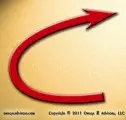Best Way to Try New Behaviors (Pt 1)
My series Change Management Tactics based on the article, The Hot Spotters, by Atul Gawande (The New Yorker, January 24, 2011 edition), assumes managers guide the process. Greger Wikstand (more), a Capgemini consultant, asked about best way to try new behaviors on his own.
Greger points out, “In the heat of the moment I keep forgetting to try.” A change of behavior often includes a change of thinking. Our minds though don’t always catch up to our intentions especially when confronting engrained habits within time constraints.
When we fail to change, we often overlook two things when we try new behaviors:
- Setting realistic expectations
- Breaking change into small steps
Studies of work, exercise or diets generally indicate it takes two to four weeks to make a behavioral change a new habit. Our bodies usually need three weeks to adapt to new environments. Change doesn’t happen overnight. We shouldn’t expect it.
We also tend to “bite off more than we can chew.” Often there are five to ten smaller changes required to make our intended change. For example, writing things down on a task list facilitates change. Simply writing, “If _____ happens, I will do _____,” helps. However, if we’re not normally doing that, it’s change too.
Combining realistic expectations with small steps, we avoid “all or nothing” attitudes. We want progress. For example, in the heat of the moment, we forget. We lost. Here’s the better question: In the last ten opportunities, how many times were we successful? Twenty percent is far better than the prior state of zero percent. It’s progress.
Another perspective asks: If we didn’t perform the change, did we realize that shortly thereafter? Raising awareness is change. It’s also another small step. How many times over the last ten opportunities were we immediately aware afterwards that we missed an opportunity?
Yes, this means documenting and measuring. When the change becomes habit, we can stop measuring. Feeling progress though encourages change. We won’t see progress if we’re not looking for it. If we don’t see progress, we won’t continue to try new behaviors.
In short, the best way to try new behaviors is to make it a game. Winning is progress.
Part 2 of Best Way to Try New Behaviors dives into a daily approach. It supplements the expectations and strategy covered here.



Thank you for the post.
Breaking changes into smaller changes does enable one to gain confidence and motivation from successful earlier changes. More importantly in my thinking, seeing the plan as five or ten (or more) steps provides natural breaks for self-assessment / refinement of plans. If you think about it, successfully planning five or ten steps before starting on a meaningful, worthwhile project seems to me to be highly unlikely! Self-assessment and refinement are the coins of the rhelm!!!
John, how do you define self-assessment differently from self-evaluation?
I went back and looked at my reply to see if I used “self-evaluation” – I didn’t as I expected (hoped) would be the case. When I use “self-assessment,” it’s all about what the education folks call Metacognition (a lot of sylables for an engineer): seeing how things are going and how can I help make things go better – in ALL aspects of “things.”
If I were to use “self-evaluation,” it would be in those situations where improvement on that ISSUE cannot continue for whatever reason. That can be the case of course and thus assessment for immediate refinement isn’t a possibility. BUT self-evaluation for future efforts must always be a priority! Personally, I never minimize tho potential opportunities for self-assessment to lead to refinement regardless of imposed timeline, thus the minimal (if at all) use of self-evaluation.
HOWEVER, “SELF-” is always important as is collaborative- of course!
Thank you, John, I understand. Too many times in the workplace people misinterpret assessing for evaluating or interchange one for the other. That’s why I asked.
It’s not unusual for qualitative responses such as “good,” “moving forward well,” “great” and many others. These are then plugged into performance reviews to determine various types of rewards. I also find that there is too much time spent on describing where we are (a status report) and not enough on what the next steps should be or where we should be going or worse yet, what decisions we need to make and who should make them. Assessments address those points.
When grading the many team reports over the years, I always insisted on not only the conclusions but, even more importantly, the recommendations for continued efforts. For those projects with a “hard” deadline – as most college assignments other than project reports are, those recommendations are so very important: acknowledges believed unfinished work, adding credibility to what has been done and alerts to things needed to be done; often results in getting the “hard” deadline extended, resulting in a better overall effort; provides credibility for requests for additional / alternative resources the next time similar efforts are requested (and they will be requested); …
Always reminded the students that the person(s) most likely to read the reports the most often will be the author(s) of them. Thus, to make them most valuable, the authors need to make sure they are complete and clear (and yet concise – my three “Cs”) – including those recommendations!!!